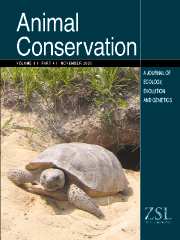Crossref Citations
This article has been cited by the following publications. This list is generated based on data provided by
Crossref.
Yang, Wei-Cheng
Pang, Victor Fei
Jeng, Chian-Ren
Chou, Lien-Siang
and
Chueh, Ling-Ling
2006.
Morbilliviral infection in a pygmy sperm whale (Kogia breviceps) from Taiwanese waters.
Veterinary Microbiology,
Vol. 116,
Issue. 1-3,
p.
69.
MIRIMIN, L.
COUGHLAN, J.
ROGAN, E.
and
CROSS, T. F.
2006.
Tetranucleotide microsatellite loci from the striped dolphin (Stenella coeruleoalba Meyen, 1833).
Molecular Ecology Notes,
Vol. 6,
Issue. 2,
p.
493.
Moore, Michael
Early, Greg
Touhey, Kathleen
Barco, Susan
Gulland, Frances
and
Wells, Randall
2007.
REHABILITATION AND RELEASE OF MARINE MAMMALS IN THE UNITED STATES: RISKS AND BENEFITS.
Marine Mammal Science,
Vol. 23,
Issue. 4,
p.
731.
GASPARI, STEFANIA
AZZELLINO, ARIANNA
AIROLDI, SABINA
and
HOELZEL, A. RUS
2007.
Social kin associations and genetic structuring of striped dolphin populations (Stenella coeruleoalba) in the Mediterranean Sea.
Molecular Ecology,
Vol. 16,
Issue. 14,
p.
2922.
Rijks, J M
Hoffman, J I
Kuiken, T
Osterhaus, A D M E
and
Amos, W
2008.
Heterozygosity and lungworm burden in harbour seals (Phoca vitulina).
Heredity,
Vol. 100,
Issue. 6,
p.
587.
Rosso, Massimiliano
Moulins, Aurélie
and
Würtz, Maurizio
2008.
Colour patterns and pigmentation variability on striped dolphin Stenella coeruleoalba in north-western Mediterranean Sea.
Journal of the Marine Biological Association of the United Kingdom,
Vol. 88,
Issue. 6,
p.
1211.
ILMONEN, P.
PENN, D. J.
DAMJANOVICH, K.
CLARKE, J.
LAMBORN, D.
MORRISON, L.
GHOTBI, L.
and
POTTS, W. K.
2008.
Experimental infection magnifies inbreeding depression in house mice.
Journal of Evolutionary Biology,
Vol. 21,
Issue. 3,
p.
834.
Rus Hoelzel, A.
2009.
Encyclopedia of Marine Mammals.
p.
736.
Townsend, Andrea K.
Clark, Anne B.
McGowan, Kevin J.
Buckles, Elizabeth L.
Miller, Andrew D.
and
Lovette, Irby J.
2009.
Disease-mediated inbreeding depression in a large, open population of cooperative crows.
Proceedings of the Royal Society B: Biological Sciences,
Vol. 276,
Issue. 1664,
p.
2057.
Smith, K. F.
Acevedo‐Whitehouse, K.
and
Pedersen, A. B.
2009.
The role of infectious diseases in biological conservation.
Animal Conservation,
Vol. 12,
Issue. 1,
p.
1.
Luca, Mirimin
Andrew, Westgate
Emer, Rogan
Patricia, Rosel
Andrew, Read
Jamie, Coughlan
and
Tom, Cross
2009.
Population structure of short-beaked common dolphins (Delphinus delphis) in the North Atlantic Ocean as revealed by mitochondrial and nuclear genetic markers.
Marine Biology,
Vol. 156,
Issue. 5,
p.
821.
Galov, Ana
Lauc, Gordan
Nikolić, Nela
Šatović, Zlatko
Gomerčić, Tomislav
Gomerčić, Martina Đuras
Kocijan, Ivna
Šeol, Branka
and
Gomerčić, Hrvoje
2009.
Records and genetic diversity of striped dolphins ( Stenella coeruleoalba) from the Croatian coast of the Adriatic Sea.
Marine Biodiversity Records,
Vol. 2,
Issue. ,
Sandland, Gregory J.
Wethington, Amy R.
Foster, Alice V.
and
Minchella, Dennis J.
2009.
Effects of host outcrossing on the interaction between an aquatic snail and its locally adapted parasite.
Parasitology Research,
Vol. 105,
Issue. 2,
p.
555.
HOFFMAN, J. I.
DASMAHAPATRA, K. K.
AMOS, W.
PHILLIPS, C. D.
GELATT, T. S.
and
BICKHAM, J. W.
2009.
Contrasting patterns of genetic diversity at three different genetic markers in a marine mammal metapopulation.
Molecular Ecology,
Vol. 18,
Issue. 14,
p.
2961.
Townsend, Andrea K.
Clark, Anne B.
McGowan, Kevin J.
Miller, Andrew D.
and
Buckles, Elizabeth L.
2010.
Condition, innate immunity and disease mortality of inbred crows.
Proceedings of the Royal Society B: Biological Sciences,
Vol. 277,
Issue. 1695,
p.
2875.
Reed, D. H.
2010.
Albatrosses, eagles and newts, Oh My!: exceptions to the prevailing paradigm concerning genetic diversity and population viability?.
Animal Conservation,
Vol. 13,
Issue. 5,
p.
448.
Panigada, Simone
Lauriano, Giancarlo
Burt, Louise
Pierantonio, Nino
Donovan, Greg
and
Clifton, Julian
2011.
Monitoring Winter and Summer Abundance of Cetaceans in the Pelagos Sanctuary (Northwestern Mediterranean Sea) Through Aerial Surveys.
PLoS ONE,
Vol. 6,
Issue. 7,
p.
e22878.
Gompper, Matthew E.
Monello, Ryan J.
and
Eggert, Lori S.
2011.
Genetic variability and viral seroconversion in an outcrossing vertebrate population.
Proceedings of the Royal Society B: Biological Sciences,
Vol. 278,
Issue. 1703,
p.
204.
Bilgmann, Kerstin
Möller, Luciana M.
Harcourt, Robert G.
Kemper, Catherine M.
Beheregaray, Luciano B.
and
Gilbert, M. Thomas P.
2011.
The Use of Carcasses for the Analysis of Cetacean Population Genetic Structure: A Comparative Study in Two Dolphin Species.
PLoS ONE,
Vol. 6,
Issue. 5,
p.
e20103.
Galov, Ana
Kocijan, Ivna
Lauc, Gordan
Gomerčić, Martina Đuras
Gomerčić, Tomislav
Arbanasić, Haidi
Šatović, Zlatko
Šeol, Branka
Vuković, Snježana
and
Gomerčić, Hrvoje
2011.
High genetic diversity and possible evidence of a recent bottleneck in Adriatic bottlenose dolphins (Tursiops truncatus).
Mammalian Biology,
Vol. 76,
Issue. 3,
p.
339.


